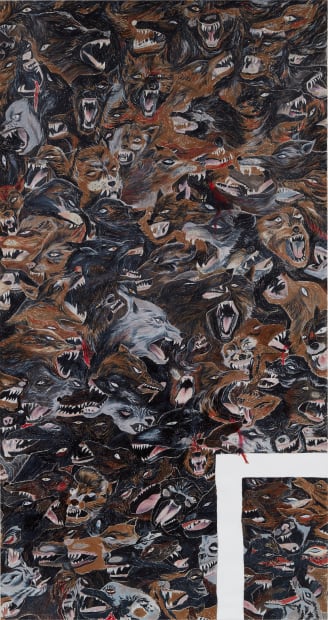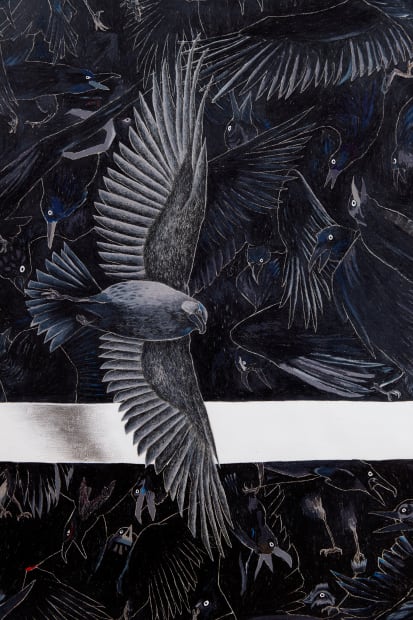-
ROBYN O'NEIL: AN UNKINDNESS
-
Reading left to right, Robyn O’Neil’s An Unkindness, a towering six-foot drawing in three parts, opens on a pack of hungry wolves. The horror and claustrophobia of the scene is amplified by the unkindness of shrieking ravens that follows close on, beating wings obliterating a rising sun. The third and final panel promises redemption, with a nod to Hokusai, in an ethereal, idyllic place. Characteristic of O’Neil’s meticulous drawing practice, thin and sharp edges define each figure in a provocative, awe-inspiring scene. A singular crow flies past the fictive frame, high above the chaos that reigns below, in search of rest and haven. As sunrise pierces the unkindness, a scene of terror giving way to a brighter future.
-
 ROBYN O'NEIL, An Unkindness, 2019
ROBYN O'NEIL, An Unkindness, 2019 -
In early religious paintings, triptychs served as a common device to tell the story of Heaven and Hell. Here, in three panels, the viewer travels through a Hell of Man's own making, absent of humans but not our impact, and on to a new world.This illustration of the Anthropocene describes an era in which humanity has permanently altered the planet. Some scientists argue it began with the 19th century Industrial Revolution while others contend it was the use of the atomic bomb in 1945. Mass extinction defines and separates the Anthropocene from previous eras. While there have been several such periods over the ages due to natural disasters, at no other point has a single species had such an impact.
-
 ROBYN O'NEIL, An Unkindness, 2019 (Right Panel Detail)
ROBYN O'NEIL, An Unkindness, 2019 (Right Panel Detail) -
 ROBYN O'NEIL, An Unkindness, 2019 (Left Panel Detail)
ROBYN O'NEIL, An Unkindness, 2019 (Left Panel Detail) -
“In her reckoning, humans negatively affect their environment, but the land, the sky, and the roiling ocean always have the proverbial last word, destroying the hubris of human ambition.”
- Matthew Bourbon, Dallas Morning News
-
 ROBYN O'NEIL, An Unkindness, 2019 (Center Panel Detail)
ROBYN O'NEIL, An Unkindness, 2019 (Center Panel Detail) -
 ROBYN O'NEIL, An Unkindess, 2019 (Center Panel Detail)
ROBYN O'NEIL, An Unkindess, 2019 (Center Panel Detail) -
 ROBYN O'NEIL, An Unkindess, 2019 (Right Panel Detail)
ROBYN O'NEIL, An Unkindess, 2019 (Right Panel Detail) -
Northern Renaissance artists, like Bosch, were noted for their vocabulary of realism and minute attention to detail. They transformed the metaphysical into a tangible reality, while their use of fictive frames and trompe l’oeil invited the viewer into the picture. These paintings were often used for meditation, prayer, and most certainly as a cautionary tale. In the same tradition, O’Neil has created a space for the audience to reflect on our effect on the planet. The scale and detail of An Unkindness encourages the viewer to linger and to reflect on the darkness of our past, the potential of our present, and hope for a better future.
-
 Installation view, Robyn O'Neil: WE, THE MASSES, Modern Art Museum of Fort Worth, Fort Worth, Texas, 2019. Photo: Kevin Todora.
Installation view, Robyn O'Neil: WE, THE MASSES, Modern Art Museum of Fort Worth, Fort Worth, Texas, 2019. Photo: Kevin Todora. -
“My triptychs also tend to explore how much I actually love the world around me. As much as my work has a dark side, it also usually ends in hope. The entire right panel is that of a heavenly scene. A place we would want to be.”
- Robyn O'Neil
-
-

ROBYN O'NEIL : An Unkindness
Past viewing_room







